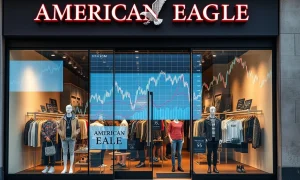The financial world often presents perplexing paradoxes. For instance, a company’s stock might surge while its underlying consumer demand appears stagnant. This intriguing scenario recently played out with American Eagle stock. Data suggests that associations with high-profile figures, such as actress Sydney Sweeney and former President Donald Trump, may have positively influenced the company’s market valuation. However, this rise in stock price did not necessarily translate into a corresponding increase in consumer purchasing. Understanding this disconnect offers crucial insights for investors and market watchers.
Understanding American Eagle Stock Performance
American Eagle Outfitters (AEO) operates as a leading global specialty retailer. It offers a range of apparel, accessories, and personal care products. The company primarily targets young consumers. Like many retail giants, its stock performance is subject to various market forces. These include economic indicators, consumer trends, and brand perception. Recently, the trajectory of American Eagle stock has captured significant attention. This is due to its surprising resilience amidst shifting market conditions. Analysts often scrutinize retail stocks closely. They look for signs of consumer health and brand strength. However, sometimes external factors can create unexpected movements.
The Sydney Sweeney Effect on American Eagle Stock
Celebrity endorsements often significantly impact a brand’s visibility and appeal. Sydney Sweeney, a prominent actress, has a strong presence among young audiences. Her association with American Eagle through various campaigns likely boosted the brand’s profile. Consequently, this increased exposure can translate into heightened investor interest. Investors often perceive celebrity partnerships as a sign of brand relevance and future growth potential. Therefore, news of Sweeney’s involvement could have contributed to positive sentiment around American Eagle stock. Her widespread popularity undoubtedly reached a broad demographic. This reach, in turn, could influence market perception more than immediate sales figures.
- Increased brand visibility among target demographics.
- Enhanced brand image and perceived coolness factor.
- Potential for greater media attention and social media buzz.
However, it is crucial to differentiate between brand awareness and direct sales conversion. While Sweeney’s influence may have made the brand more appealing to investors, the actual impact on consumer spending requires deeper analysis. Market enthusiasm does not always align perfectly with real-world purchasing habits. Consequently, investors must look beyond surface-level trends.
Political Figures and American Eagle Stock Volatility
The involvement of political figures, even indirectly, can also stir market reactions. Reports suggesting former President Donald Trump’s potential influence on American Eagle’s stock are particularly noteworthy. This influence might stem from various factors. For example, some investors might view an association, however tenuous, as a positive sign of a brand’s appeal to a specific demographic. Conversely, others might react negatively. Political associations can be polarizing. They can alienate certain customer segments. However, the stock market often reacts to perceived shifts in consumer base or investor confidence. Therefore, any perceived link to a political figure, whether direct or indirect, could introduce a layer of volatility to American Eagle stock. This complexity highlights the unpredictable nature of market sentiment.
Decoding the Demand Disconnect for American Eagle Stock
The core paradox lies in the apparent divergence between stock performance and consumer demand. Typically, a company’s stock price reflects its expected future earnings. These earnings are heavily reliant on sales and consumer spending. When American Eagle stock rises without a corresponding increase in demand, it suggests other factors are at play. Several elements can contribute to this disconnect. Investor sentiment, for example, might be driven by speculative buying. It could also be influenced by broader market trends. These trends might not directly reflect the company’s current sales figures. Furthermore, short-term trading activities can create temporary surges. These surges do not always indicate long-term consumer interest. Understanding these dynamics is vital for a complete picture.
Investor Sentiment Versus Consumer Spending on American Eagle Products
Investor sentiment plays a significant role in stock valuation. It represents the overall attitude of investors towards a particular stock or market. Positive sentiment can drive prices up, even if fundamental demand remains flat. For instance, investors might buy American Eagle stock based on:
- Anticipation of future growth due to new marketing strategies.
- Belief in the brand’s long-term resilience.
- Broader market rallies that lift all boats.
Conversely, consumer spending directly measures how much customers are buying. Data from credit card transactions, foot traffic, and online sales provide a clearer picture of actual demand. When these demand indicators do not align with stock gains, it suggests a speculative bubble or an overestimation of future sales. Therefore, a careful analysis requires looking beyond just the stock price. It involves examining underlying sales data and consumer behavior patterns. This distinction is crucial for informed investment decisions.
Broader Market Trends Impacting American Eagle Stock
The retail sector constantly faces challenges and opportunities. E-commerce growth, changing consumer preferences, and economic fluctuations all play a part. The performance of American Eagle stock does not occur in a vacuum. It is influenced by these wider market trends. For instance, inflation can impact discretionary spending. Supply chain issues can affect inventory and pricing. Moreover, the competitive landscape in fashion retail is intense. Brands constantly vie for consumer attention and loyalty. Therefore, while celebrity and political associations might offer short-term boosts, sustainable growth depends on core business fundamentals. These fundamentals include product innovation, efficient operations, and effective customer engagement. Understanding these broader trends provides context for the stock’s movements.
Future Outlook for American Eagle Stock and Retail Strategy
The disconnect between stock performance and demand presents a challenge for American Eagle. Moving forward, the company must focus on converting brand awareness into tangible sales. This involves refining its retail strategy. For instance, investing in digital channels is essential. Enhancing the in-store experience also remains important. Furthermore, understanding evolving consumer preferences will be key. This helps in developing products that truly resonate with the target market. Ultimately, the long-term health of American Eagle stock depends on its ability to drive consistent consumer demand. Marketing efforts, while impactful, must translate into sustained revenue growth. The company’s future trajectory will likely hinge on its adaptability and strategic foresight in a dynamic retail environment.
In conclusion, the performance of American Eagle stock highlights the complex interplay of market sentiment, celebrity influence, and actual consumer demand. While high-profile associations may generate investor interest and drive stock prices upward, they do not automatically guarantee increased sales. Investors must look beyond headline-grabbing events. They need to analyze underlying business fundamentals and consumer spending patterns. This comprehensive approach provides a more accurate picture of a company’s true health and future prospects. The retail landscape remains challenging, and only brands that align market perception with real demand will thrive long-term.
Frequently Asked Questions (FAQs)
Q1: Why might American Eagle’s stock rise without increased consumer demand?
A1: Several factors can cause this disconnect. Investor sentiment, driven by anticipation of future growth or speculative trading, can push stock prices up. Celebrity endorsements or perceived political affiliations might also create positive market buzz, leading to increased buying interest among investors, even if actual consumer spending on products remains flat. Broad market trends can also lift all stocks, including American Eagle’s, regardless of individual company demand.
Q2: How do celebrity endorsements typically affect stock prices?
A2: Celebrity endorsements can significantly boost a brand’s visibility and perceived desirability. This often translates into heightened investor interest and positive sentiment, potentially driving up stock prices. Investors may view these partnerships as a sign of strong marketing and future revenue potential. However, the direct impact on sales is not always immediate or proportionate to the stock’s rise.
Q3: What is the Flesch Reading Ease Score, and why is it important for articles like this?
A3: The Flesch Reading Ease Score measures how easy a text is to understand. A score of 60 or higher indicates that the content is relatively easy for a broad audience to read. For articles like this, which discuss financial topics, a good Flesch score ensures that complex information is accessible to a wider readership, including those without a finance background, enhancing engagement and comprehension.
Q4: How does consumer demand data differ from stock performance indicators?
A4: Consumer demand data directly reflects what customers are buying, often measured through sales figures, foot traffic, and online purchases. Stock performance indicators, on the other hand, show how a company’s shares are trading on the market. While stock performance is ideally linked to demand, it can also be influenced by investor speculation, market sentiment, and macroeconomic factors that do not always align with current sales.
Q5: What should investors consider when evaluating American Eagle stock?
A5: Investors should consider a holistic view beyond just stock price movements. This includes analyzing actual sales data, consumer spending trends, the effectiveness of marketing campaigns, the company’s financial health, competitive landscape, and broader retail sector trends. Relying solely on short-term stock fluctuations or celebrity associations can be misleading; a focus on long-term fundamentals is crucial.
























